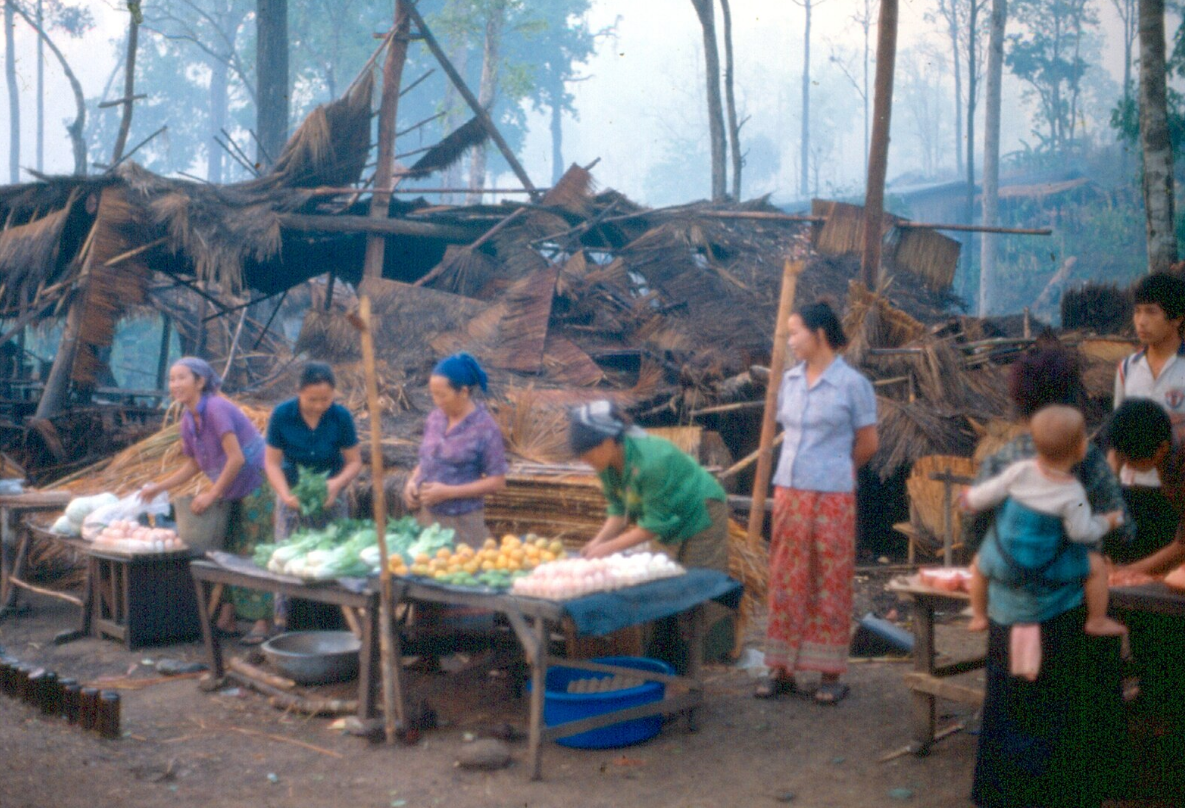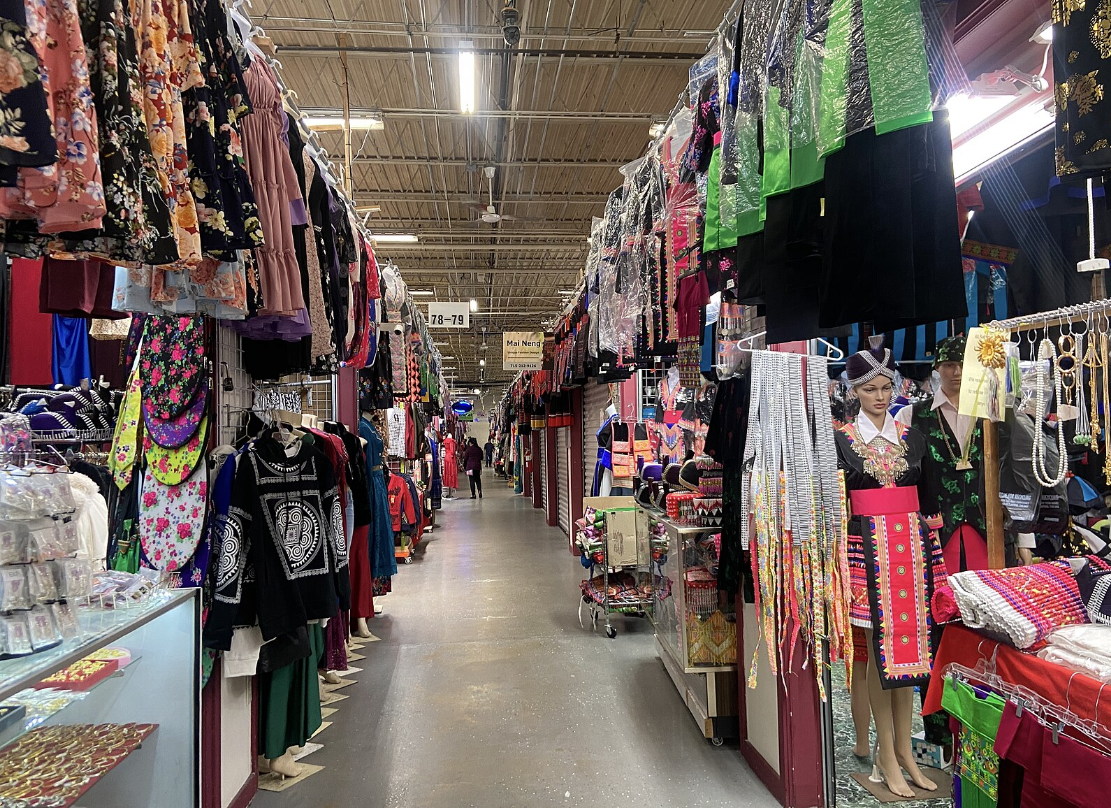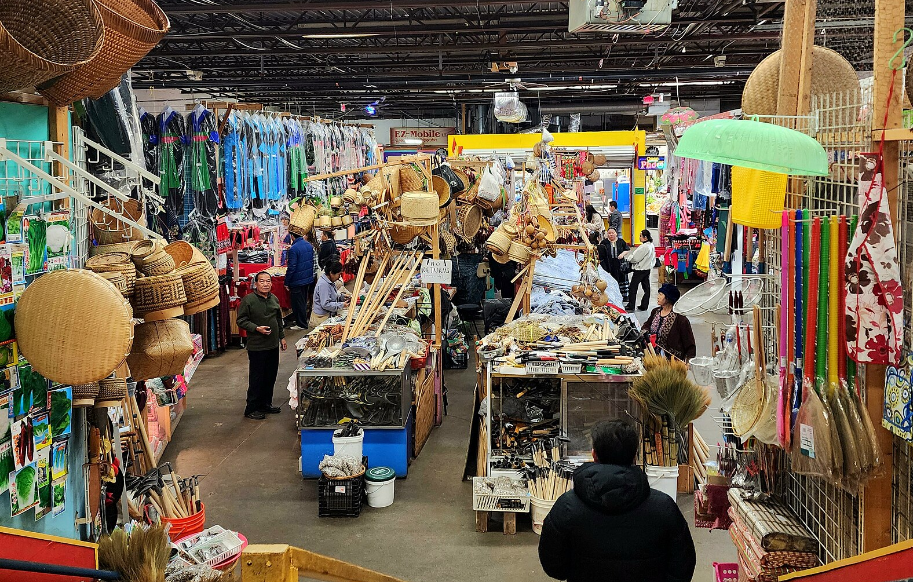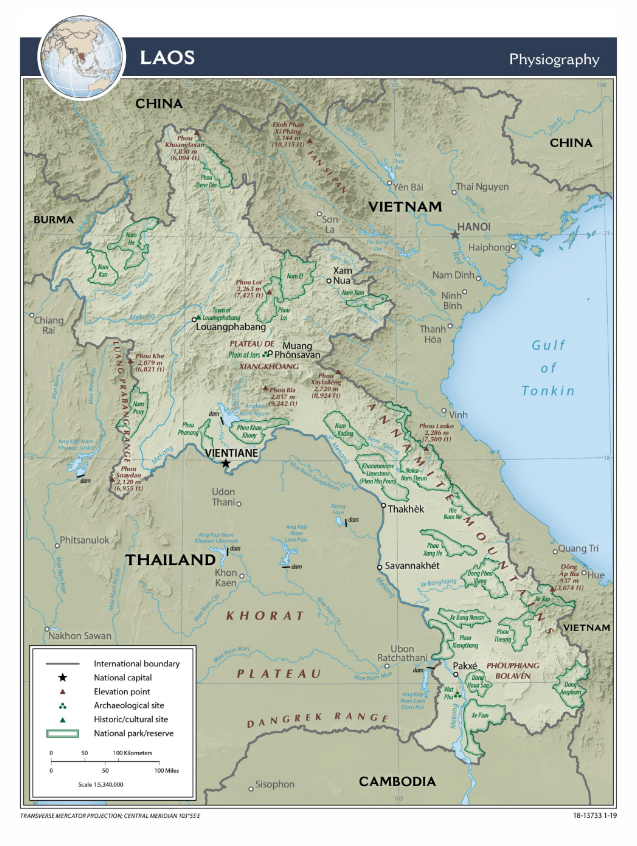Hmongtown Marketplace in an indoor-outdoor marketplace in St. Paul, Minnesota with over 100 businesses and shops. There is a large population of Hmong Americans in St. Paul.
Credit: Pingnova, CC0, via Wikimedia Commons
Grade: 9-12Subject:
U.S. History, Social Studies, English Language Arts
Number of Activities: 4
During the Laotian Civil War (1959-1975) and Vietnam War (1955-1975), the United States Central Intelligence Agency (CIA) recruited Hmong soldiers in Laos to fight in a “Secret War” on behalf of the United States. When those wars ended in 1975, thousands of Hmong in Laos faced persecution and sought to evacuate. Many eventually resettled in the United States. In this lesson, students will learn about the resettlement experiences of Hmong refugees in the United States. Students will analyze oral histories recorded by Hmong refugees.
Students will:
- Identify causes and effects of the “Secret War” in Laos.
- Describe challenges and opportunities faced by Hmong refugees in the United States.
- Analyze oral histories to learn more about the Hmong refugee experience.
Hmong Refugees in the United States Essay:
The Hmong are an ethnic group with roots in China. They have lived there for thousands of years, but were
persecuted during the Qing dynasty (1644–1911) in China and forced to migrate south. As such, they are “
stateless,” or a people without a
homeland. In the 18th and 19th centuries, many Hmong migrated to Southeast Asia, including Laos.
Civil War erupted in Laos in 1959 between the
communist Pathet Lao and the anticommunist Royal Lao Government. (“Pathet Lao” means “Lao Nation” or “Lao Country.” The Royal Lao Government ruled the Kingdom of Laos from 1947-1975.) Laos is
landlocked between Thailand, Cambodia, Vietnam, China, and Myanmar, and parts of Laos were occupied by communist North Vietnamese troops. Guided by the “
domino theory” that if one country falls to communism, others in the region would follow, the United States tried to influence Lao politics and sought a greater military presence in Laos. However, they were limited by the 1962 Geneva Accords, an international agreement in which all foreign troops were required to leave Laos, as Laos was declared to be
neutral. So, the Central Intelligence Agency (CIA) began to recruit soldiers to engage in a “Secret War” on behalf of the United States. This “secret army,” which included many Hmong soldiers, helped the United States combat the North Vietnamese in the Vietnam War (1955-1975).
The CIA recruited a young Hmong military officer in the Royal Lao Army named Vang Pao (1929-2011) to enlist Hmong soldiers for the Secret War. (Because the war was covert, there is little written documentation of their correspondence, but many Hmong believe that the United States promised Vang Pao a Hmong homeland in exchange for their support.) By 1969, Vang Pao had recruited 40,000 soldiers for the secret army.
When the Vietnam War (1955-1975) ended with the fall of Saigon in 1975, the Pathet Lao had gained power in Laos and targeted the Hmong. Thousands of Hmong in Laos sought to evacuate. However, the United States did not lead large-scale
evacuations in Laos as it had in Vietnam. Only 2,500 Hmong were evacuated by the United States in May 1975.
By December 1975, the Pathet Lao began to establish prisons for Hmong in Laos who were suspected of working with Vang Pao. By 1980, over 100,000 Hmong fled Laos for
refugee camps in Thailand. A fraction of those were eventually
resettled in the United States.
By the late 1970s and 1980s, Americans were feeling a sense of “
compassion fatigue.” People were growing tired of supporting the waves of refugees coming to the United States as a result of U.S. involvement in the Vietnam War and other conflicts in Southeast Asia. The initial sense of
humanitarian duty was replaced with growing anti-immigrant and anti-refugee sentiment and beliefs that refugees were taking away jobs and resources from Americans.
U.S. resettlement policy focused on geographic
dispersal in order to ease the social and financial burden of resettling refugees. By spreading out the refugees in different cities across the nation, no one city would have to absorb the costs. This dispersal strategy was also supposed to encourage
assimilation. However, resettling Hmong in different cities conflicted with the Hmong
clan structure, which is built on strong community bonds and a collective support system. There were few networks of support for Hmong refugees to find jobs and housing. They faced many challenges navigating their new lives in the United States. In addition, many Hmong refugees encountered obstacles due to limited formal education and language barriers. With few resources and support, these circumstances contributed to higher rates of unemployment and poverty.
Hmong refugees also faced challenges related to shifting gender roles. Traditionally, Hmong culture is
patriarchal, in which the men are the absolute heads of the family and community. However, increased opportunities and access to education and language resources have led to a shift in dynamics at home and within their communities. Today, many Hmong women are in leadership roles, achieving remarkable educational success and spearheading community initiatives.
Intergenerational dynamics were also changing. As children became bilingual and their English language skills outperformed their parents, they often found themselves stepping into the role of translators for their parents. While this strengthened connections, it also led to many adults feeling vulnerable and dependent on their children, which can be a difficult experience for both generations.
In addition to challenges within communities, Hmong refugees faced racism and discrimination. The media frequently showed them in stereotypical ways. They were portrayed as foreigners with
primitive customs who could not assimilate into the United States. Like many other refugees, Hmong were perceived as “
freeloaders” who were taking from the system without contributing. The fact that many Hmong became refugees because of their involvement in fighting on behalf of the United States was often overlooked.
Over time, Hmong refugees began to establish a sense of community. For example, the Hmong population grew in the Twin Cities area of Minneapolis-St. Paul in Minnesota. The first Hmong refugees in St. Paul were
sponsored by members of Dayton Presbyterian Church in 1976. As the community grew, Hmong refugees living elsewhere in the United States began to relocate to the Twin Cities. They established mutual assistance organizations and other networks to help each other with jobs, schools, housing, and other aspects of daily life. As younger generations grew up, they began creating new organizations and engaging in local politics. Sizable Hmong communities also formed in Fresno and Sacramento in California, and in Milwaukee and in Wisconsin.
Hmong Americans today continue to define and redefine what it means to be Hmong American, how to preserve Hmong culture in the United States, and how to resist the racism and discrimination they face. They also continue to navigate gender and generational roles within the community. Like many other refugees, they have formed resilient communities and made a home in the United States.
Bibliography:
Lee, Erika. (2015). The Making of Asian America: A History. New York: Simon & Schuster.
- Assimilate: to absorb into the cultural tradition of a population or group
- Clan: a group of people tracing descent from a common ancestor; there are 18 clans in the Hmong community
- Communism: a system in which goods are owned in common and are available to all as needed
- Compassion fatigue: apathy or indifference toward the suffering of others as the result of overexposure to tragic news stories and images and the subsequent appeals for assistance
- Dispersal: the act of spreading widely
- Domino theory: a theory that if one nation becomes Communist-controlled the neighboring nations will also become Communist-controlled
- Evacuation: to withdraw from a place in an organized way especially for protection
- Freeloader: a person who imposes upon another’s generosity or hospitality without sharing in the cost or responsibility involved
- Homeland: the native land or country of one's parents, one's ancestors, or oneself
- Humanitarian: promoting human welfare and social reform
- Landlocked: enclosed or nearly enclosed by land
- Neutral: not engaged on either side
- Patriarchal: social organization marked by the supremacy of men
- Refugee: a person who flees to a foreign country or power to escape danger or persecution
- Resettle: to move to a new place to live after a disturbance or upheaval
- Persecute: to subject a person or group to hostility or punishment, especially because of their ethnicity, religion, or sexual orientation or political beliefs
- Primitive: characteristic of an early stage of development; little evolved
- Sponsor: one who assumes responsibility for some other person or thing
- Stateless: having no state; not recognized as a citizen of any country; having no homeland
- Who are the Hmong?
- Why did the U.S. CIA recruit Hmong soldiers for the “Secret War”?
- Why was the “Secret War” a secret?
- What were the consequences of the Pathet Lao victory in Laos for the Hmong in Laos?
- Why was there a sense of “compassion fatigue” in the United States?
- What were the impacts of U.S. resettlement policy for Hmong refugees?
- In what ways was life in the United States incompatible with Hmong customs?
- How were Hmong refugees viewed and treated by other Americans?
- How did Hmong refugees establish a sense of community in the United States?
Map of Laos
Credit: United States Central Intelligence Agency
Activity 1: Examining a Hmong Poem
- Have students locate Laos on a map (or use Google map) and describe its geographic location. Tell students that Laos is landlocked between Thailand, Cambodia, Vietnam, China, and Burma (present-day Myanmar). Ask students the following question: “How is Laos’ geographic location relevant to the U.S. involvement in the Vietnam War?”
- Have students read the article entitled, “What does it mean to have no homeland? This haunting poetry searches for answers.”
- Have students read or listen to the poem entitled, “Calling the Lost” by Mai Der Vang at the bottom of the article. Encourage students to do a close reading of the poem.
- Facilitate a discussion by asking the following questions:
- What does a “homeland” mean to you?
- In what ways are the Hmong people “always in exile”?
- What do you think the ant in the poem represents?
- How did Mai Der Vang use poetry to express her feelings?

Ban Vinai Refugee Camp circa 1980-1991. Ban Vinai was a refugee camp in Thailand from 1975-1992 that primarily housed Hmong people who were fleeing Laos. Many refugees eventually settled in the United States and other countries.
Credit: Ken and Visakha Kawasaki (kawasaki@brelief.org), CC0, via Wikimedia Commons
Activity 2: Identifying Causes and Effects of the Secret War
- Have students read the essay. Consider the following options:
- OPTION 1: Have students read the essay independently either for homework or during class time.
- OPTION 2: Read aloud the essay and model annotating.
- OPTION 3: Have students read aloud in pairs or small groups.
- Facilitate a class discussion by asking students the Discussion Questions.
- Have students watch the video entitled, “What was the Secret War in Laos?”
- Distribute the worksheet entitled, “Cause and Effect: The Secret War.” Have students use the essay and video to complete the worksheet.
- Have students list the causes of the “Secret War” in the boxes on the top half of the page.
- Tell students that causes can include circumstances, events, and actions, and that causes can be long-term or short-term.
- Have students highlight long-term causes.
- Have students list the effects of the “Secret War” in the boxes on the top half of the page.
- Tell students that effects can also be long-term or short-term. Have students highlight long-term effects.
- Reread this sentence from the essay: “Like many other refugees, Hmong were perceived as ‘freeloaders’ who were taking from the system without contributing. The fact that many Hmong became refugees because of their involvement in fighting on behalf of the United States was often overlooked.”
- Have students compose a Quickwrite responding to this sentence.
- Have students pair-share their responses.
- Facilitate a discussion by asking students the following question: “What does this sentence convey about U.S. ideologies about immigrants?”
- Facilitate a discussion using the following questions:
- How did Hmong soldiers serve the United States?
- Why do you think their contributions to the United States were not recognized?

Vue Her is a Hmong farmer on a 10-acre field, who grows several Asian specialty crops in Singer, California, near Fresno. Many Hmong refugees who resettled in California work in agriculture. (November 9, 2018)
Credit: United States Department of Agriculture, Public domain, via Wikimedia Commons
Activity 3: Analyzing Oral Histories
- Tell students that an oral history is a type of primary source in which firsthand accounts of history are preserved by recording personal recollections of history, usually through interviews. Facilitate a discussion by asking students the following questions:
- Why do you think oral history is important?
- How can oral history methodology help historians learn about the past?
- What are other ways historians can learn about the past?
- What are potential shortcomings of oral histories?
- What might you be able to learn from listening to oral histories recorded by Hmong refugees in the United States?
- Distribute the worksheet entitled, “Oral History Analysis.” Have students read the questions on the worksheet. Ask if they have any questions and clarify any misunderstandings.
- Divide students into 6 groups, and assign each group to listen to one of the following oral histories listed below. Have students follow along by downloading a transcript of the interview under “Documents” on the right side of the linked webpage, which includes translations to English. (Note to teachers: Each interview is about an hour long. In the interest of time, we have selected the clips below for students to analyze. You may wish to assign the additional clips for homework.)
- Group 1: Interview with Bo Thao: Part 1 and Part 2
- Group 2: Interview with Cher Vang: Part 1 and Part 2
- Group 3: Interview with Xeng S. Yang: Part 1 and Part 2
- Group 4: Interview with Khou Xiong: Part 1 and Part 2
- Group 5: Interview with Nhia Y. Yang: Part 1 and Part 2
- Group 6: Interview with Ge Yang: Part 1 and Part 2
- Have students complete the “Oral History Analysis” for each interview they listen to.
- For Part 1, have students complete the “Observe” section by answering the following questions:
- What is the modality (i.e., audio, video, written transcript, written document, etc.)?
- Who is telling the story? What do you know about them?
- Is there an interviewer? What do you know about them?
- When did the events being described take place? What events were happening at this time?
- What other observations can you make?
- Have students complete the “Analyze” section by answering the following questions:
- What are the limitations of the modality? What’s missing?
- What purpose does the storyteller have in telling their story?
- What are the storyteller’s main claims? What is the storyteller revealing?
- What is the storyteller’s point of view?
- What emotions or moods are being conveyed by the storyteller? How do you know?
- What might be missing from this oral history?
- Have students complete the “Reflect” section by answering the following questions:
- What did you learn from this oral history?
- What is the emotional impact of this oral history? How did this oral history affect you?
- What other questions would you ask this person? What more do you want to know?
- For Part 2, have students answer the following questions:
- In your own words, summarize the oral history.
- Why is this oral history important?
- Think about the historical events described in the oral history.
- How does the oral history affirm or build upon what you have learned?
- Are there any inconsistencies? If so, what might account for the inconsistencies?
Have students form new groups of 6, with one student representing each of the oral histories. Have each student present a summary of the oral history they listened to, using the “Oral History Analysis” as a guide.
- Have students work together to identify recurring themes and common experiences across the oral histories
- Have students identify differences across the oral histories they listened to and discuss what might account for these differences.
Reconvene as a whole group. Facilitate a discussion by asking the following questions:
- What did you learn from listening to oral histories recorded by Hmong refugees in the United States?
- What role does oral history play compared to other ways of learning about the past?

Hmong Village Shopping Center in St. Paul, Minnesota.
Credit: Myotus,
CC BY 4.0, via Wikimedia Commons
Activity 4: Summarizing the Experiences of Hmong Americans
- Have students write an informative/explanatory essay in response to the following prompt: “What are the experiences of Hmong refugees in the United States?” Have students cite evidence from the sources examined in this lesson, including essay, video, and oral histories. Have students address the following questions in their essay:
- What factors led to the resettlement of Hmong refugees in the United States?
- What challenges did Hmong refugees face?
- How did they form resilient communities?
- Have students read about the experiences of Vietnamese, Cambodian, Laotian, and Hmong refugees in The Asian American Education Project article entitled, “Southeast Asian Refugees: Make Them Count.” Have students discuss ways in which each group’s experiences were similar, and ways in each group’s experiences were distinct.
- Have students reread the poem from Activity 1, “Calling the Lost” by Mai Der Vang in the article entitled, "What does it mean to have no homeland? This haunting poetry searches for answers." Have students write an essay explaining their interpretation of the poem based on what they learned in this lesson. Have students write their own poems on what homeland means to them.
- Have students research a famous Hmong American and write a report about the person’s immigration story and contributions to the United States.
- Have students collect an oral history from one of their family members who can speak to their familial immigration story.
D2.His.6.9-12.
Analyze the ways in which the perspectives of those writing history shaped the history that they produced.
D2.His.7.9-12.
Explain how the perspectives of people in the present shape interpretations of the past.
D2.His.14.9-12.
Analyze multiple and complex causes and effects of events in the past.
D2.His.15.9-12.
Distinguish between long-term causes and triggering events in developing a historical argument.
D2.His.11.9-12.
Critique the usefulness of historical sources for a specific historical inquiry based on their maker, date, place of origin, intended audience, and purpose.
CCSS.ELA-LITERACY.RH.9-10.9
Compare and contrast treatments of the same topic in several primary and secondary sources.
CCSS.ELA-LITERACY.RH.11-12.8
Evaluate an author's premises, claims, and evidence by corroborating or challenging them with other information.
CCSS.ELA-LITERACY.RH.11-12.9
Integrate information from diverse sources, both primary and secondary, into a coherent understanding of an idea or event, noting discrepancies among sources.






